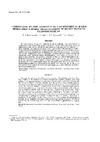Please use this identifier to cite or link to this item:
https://accedacris.ulpgc.es/jspui/handle/10553/1104
| Title: | Temperatura de emplazamiento de las ignimbritas Roque Nublo (Gran Canaria, Islas Canarias) mediante técnicas paleomagnéticas | Other Titles: | Depositional temperatures of the Roque Nublo ignimbrites, Gran Canaria, using palaeomagnetic techniques | Authors: | Perez-Torrado, Francisco-Jose Soler, V. Mangas, José Carracedo, J. C. |
UNESCO Clasification: | 250613 Petrología ígnea y metamórfica | Keywords: | Rocas ígneas Paleomagnetismo Canarias Gran Canaria |
Issue Date: | 1994 | Publisher: | 0367-0449 | Project: | 69-198 ( Dirección General de Universidades e Investigación, Consejería de Educación, Cultura y Deportes del Gobierno de Canarias) 22-1993 ( Dirección General de Universidades e Investigación, Consejería de Educación, Cultura y Deportes del Gobierno de Canarias) |
Journal: | Estudios Geologicos | Abstract: | The main characteristic of the Pliocene volcanic phase of Gran Canaria. the Cycle 11 or Roque Nublo. is the building of a central stratovolcano. probably reaching more than 2.500 m aboye sea level. Among the most relevant deposits associated to this volcanic edifice are the pyroclastic breccia-type deposits. generally known as «Roque Nublo agglomerates or breccias». These deposits have been gene rally interpreted as pyroclastic flows. However, their emission. transport and depositional mechanisms are hitherto poorly understood. In the present work. the analysis of the paleomagnetic characteristics of the lithic and juvenile fragments and the matrix of these pyroclastic deposits have provide sorne important constraints in their evolution and depositional temperatures. The Roque Nublo ignimbrites seem to have been deposited at temperatures below 300 ºC. In such circumstances. hot water originated by the condensation of interstitial water vapor reacted with the cineritic glass fraction, giving place to zeolite neomineralizations. The relatively fast cooling experimented by the ignimbrites after their emission. as deduced from the paleomagnetic analysis, can be explained by the high proportion of lithics and the intcraction of water as an important factor in the triggering of the eruptions in which the ignimbrites were originated. En Gran Canaria, el Ciclo 11 o Roque Nublo. de edad Pliocena. se caracteriza por la construcción de un estratovolcán que pudo alcanzar al menos 2.500 m de altura. Entre los materiales emitidos por este edificio volcánico destacan unos depósitos piroclásticos de aspecto brechoide. generalmente conocidos como «aglomerados o brechas Roque Nublo». Aunque la mayoría de los autores que han estudiado estos depósitos han coincidido en asociarlos a coladas piroclásticas (por consiguiente. son depósitos ignimbríticos). no se conocían bien sus mecanismos de emisión. transporte y depósito. En este trabajo se ha podido caracterizar con el auxilio de técnicas paleomagnéticas. la evolución y temperatura de depósito de estos materiales. En conjunto. las ignimbritas Roque Nublo se depositaron a temperaturas inferiores a los 300 oC, lo que permitió que el vapor de agua que incorporaban pasara muy rápidamente a fase líquida, alterando la fracción vítrea cinerítica y neoformando zeolitas. El brusco enfriamiento sufrido por estas ignimbritas desde el momento de su emisión hasta su depósito se puede explicar en función de la gran cantidad de líticos que incorporan y de los procesos de interacción agua-magma que desencadenaron las erupciones en que se produjeron. |
URI: | https://accedacris.ulpgc.es/handle/10553/1104 | ISSN: | 0367-0449 | DOI: | 10.3989/egeol.94501-2304 | Source: | Estudios Geológicos [ISSN 0367-0449 ], v. 50 (1-2), p. 9-17 |
| Appears in Collections: | Artículos |
SCOPUSTM
Citations
2
checked on Jun 8, 2025
Page view(s)
179
checked on Nov 30, 2024
Download(s)
223
checked on Nov 30, 2024
Google ScholarTM
Check
Altmetric
Share
Export metadata
Items in accedaCRIS are protected by copyright, with all rights reserved, unless otherwise indicated.
